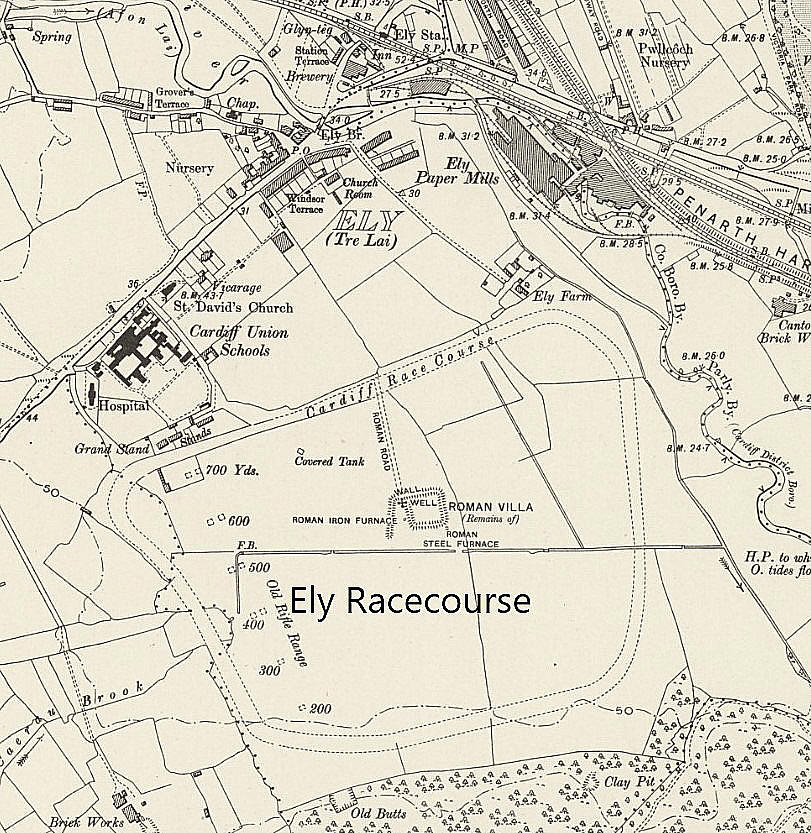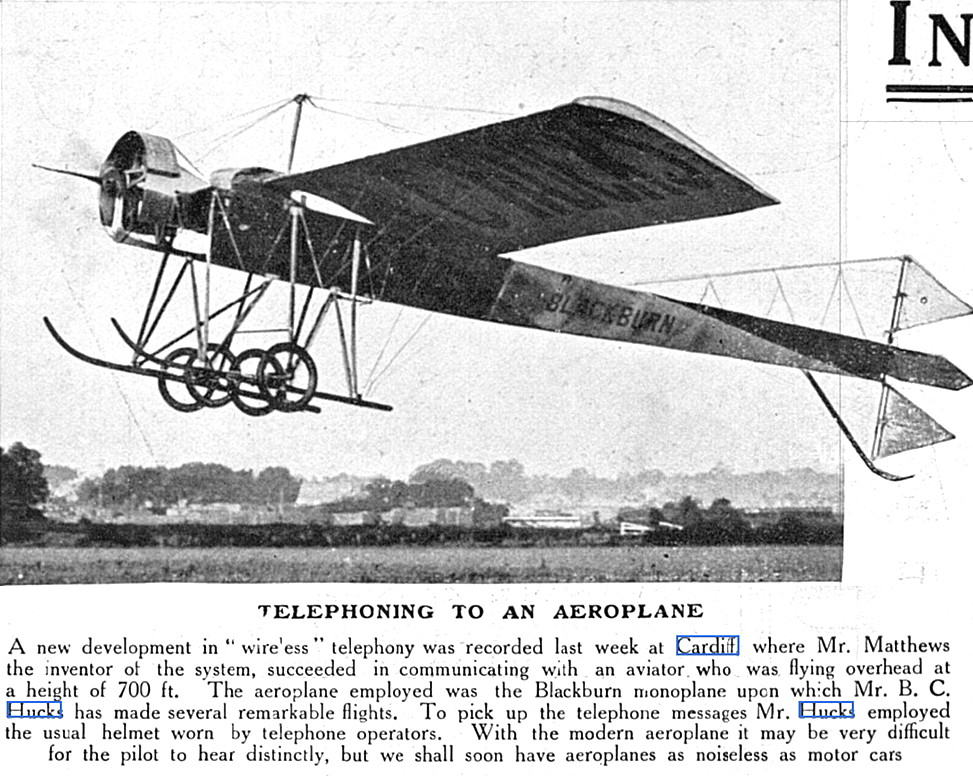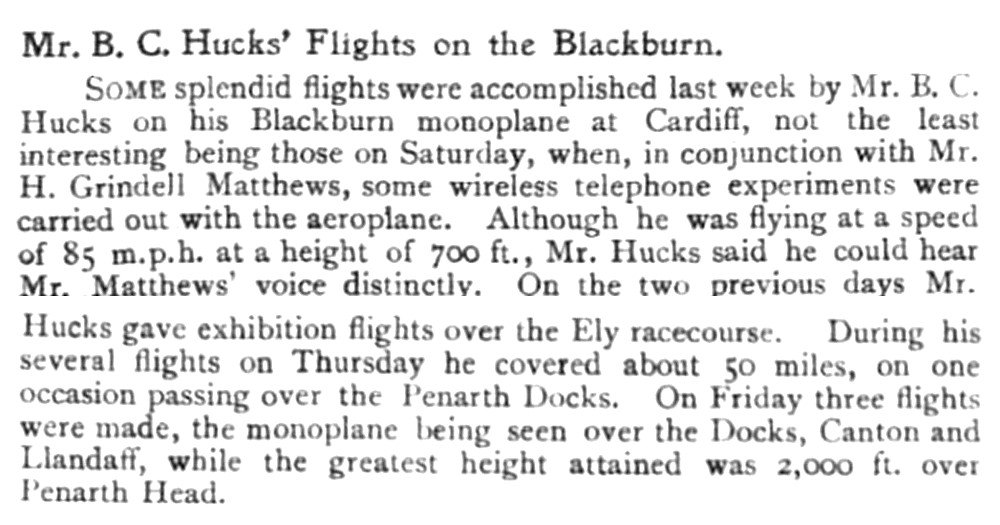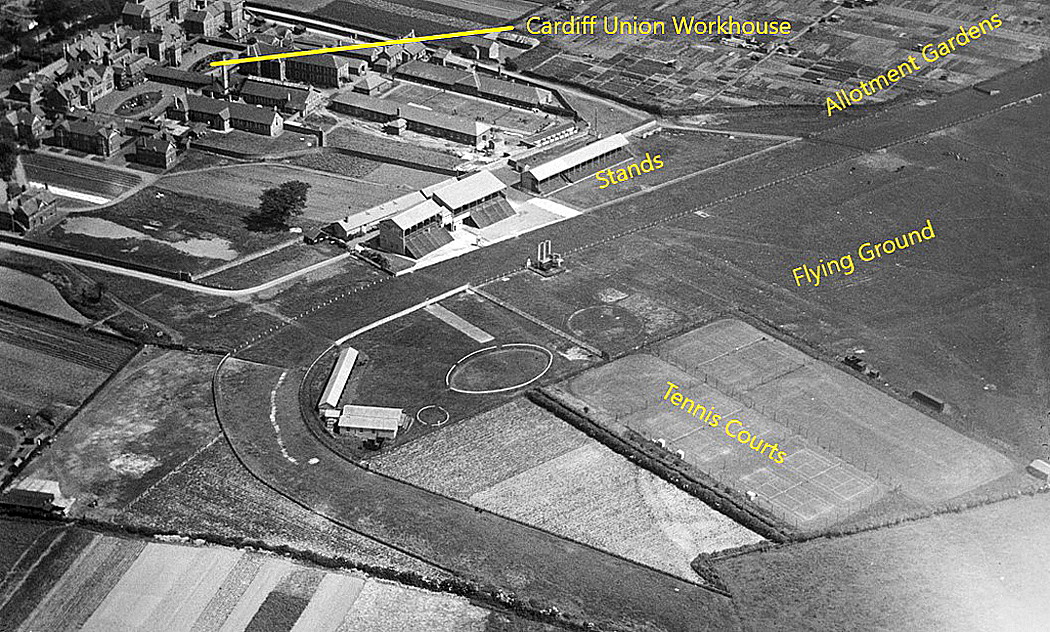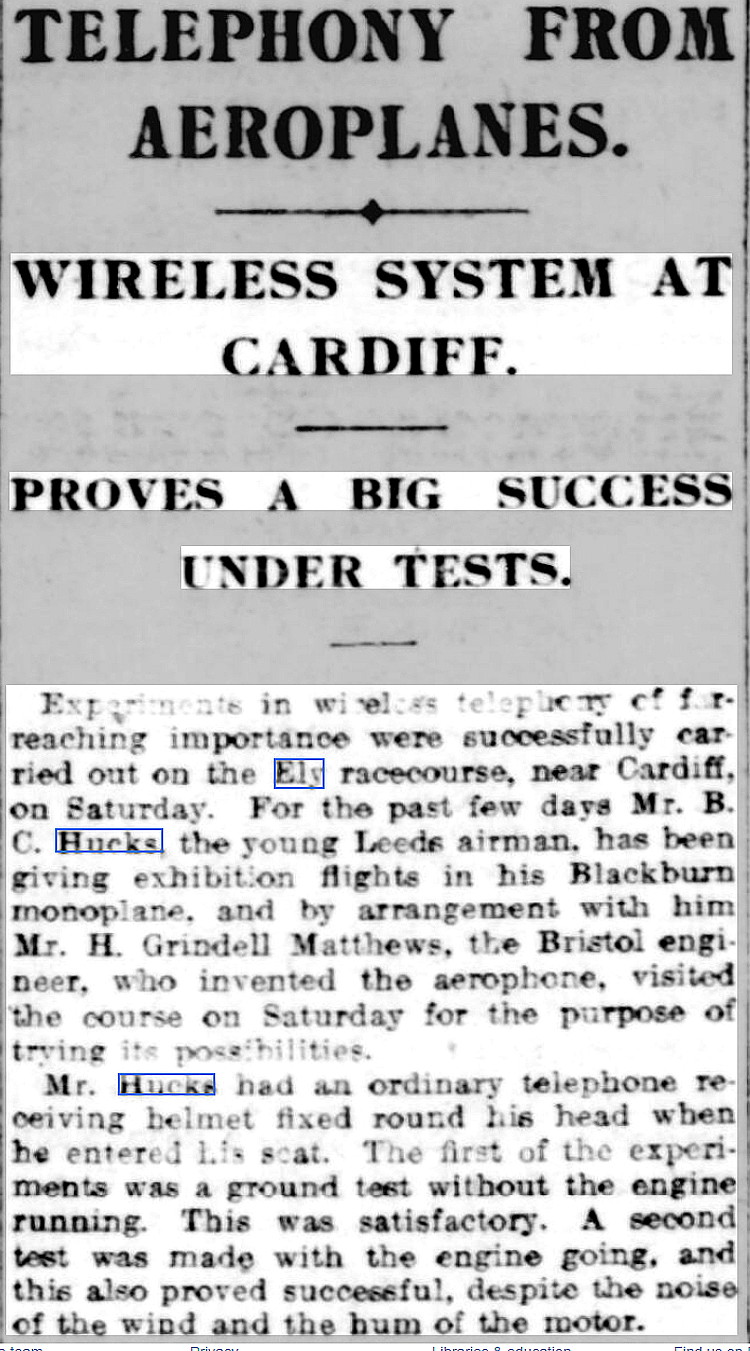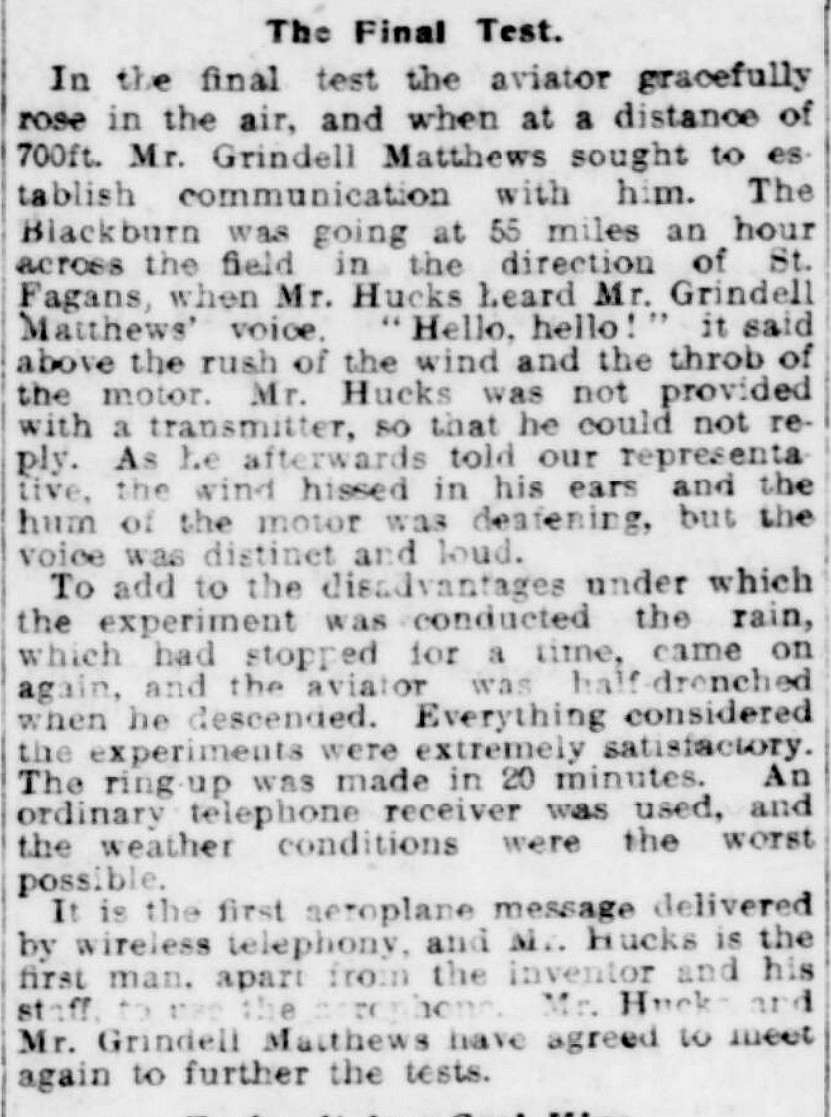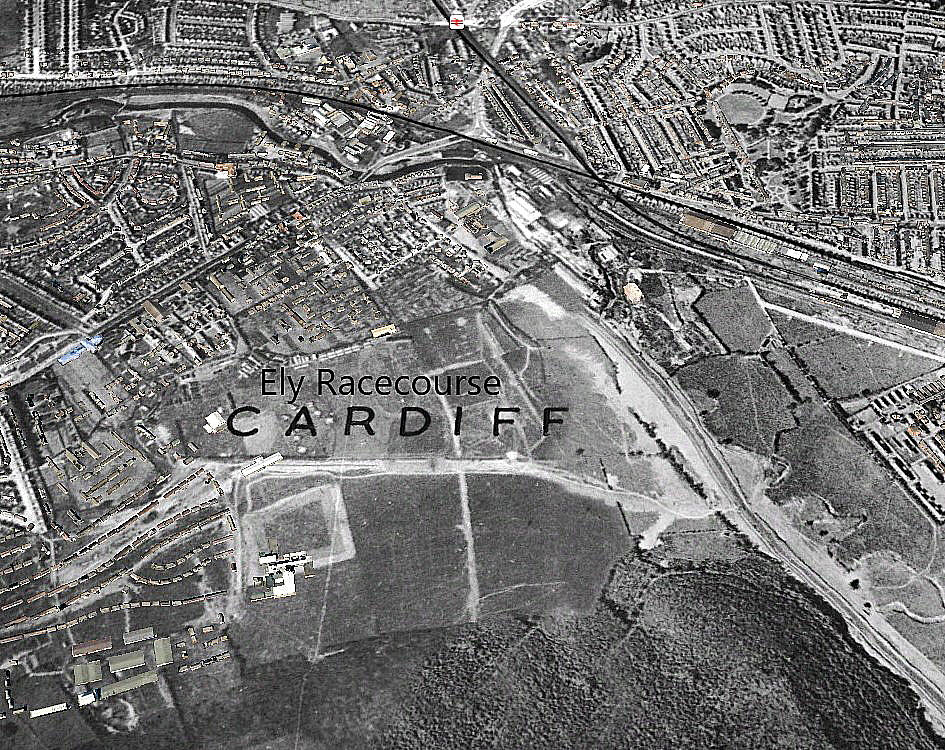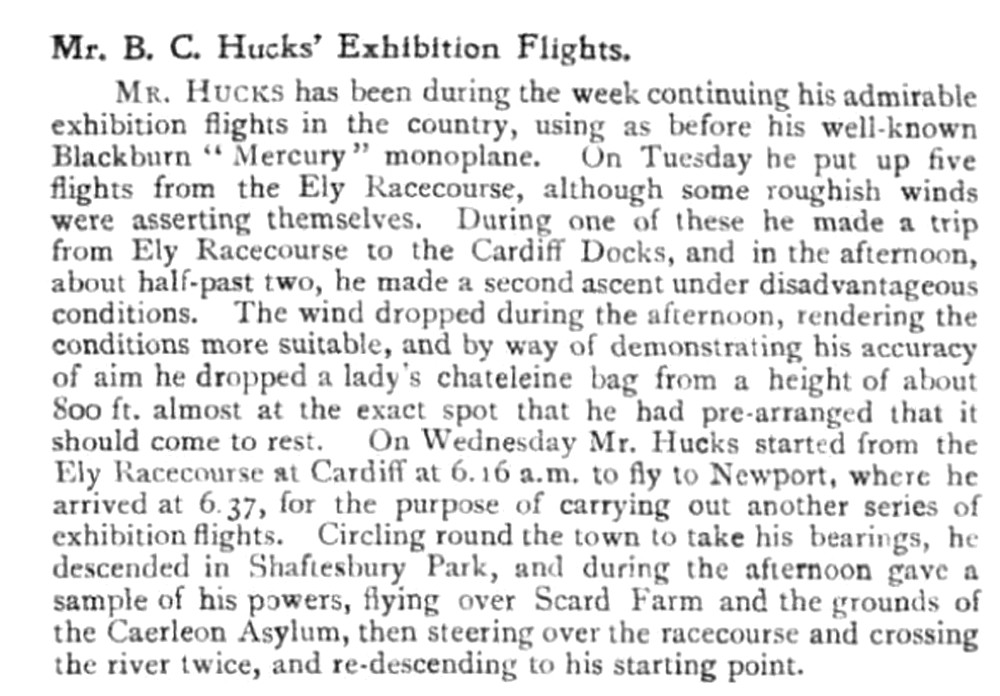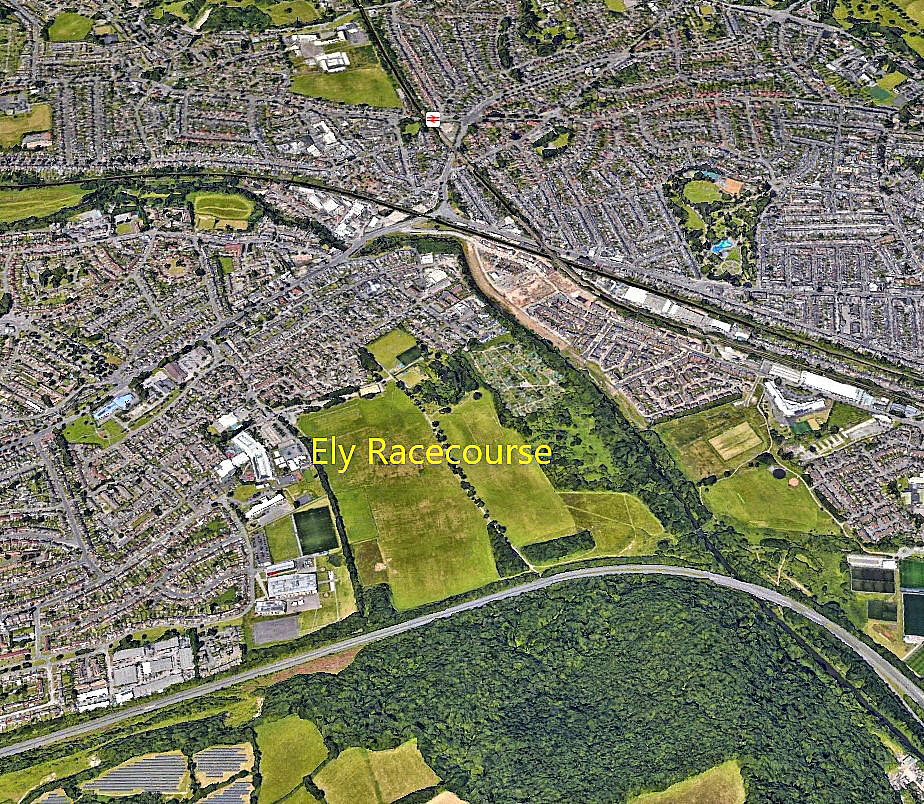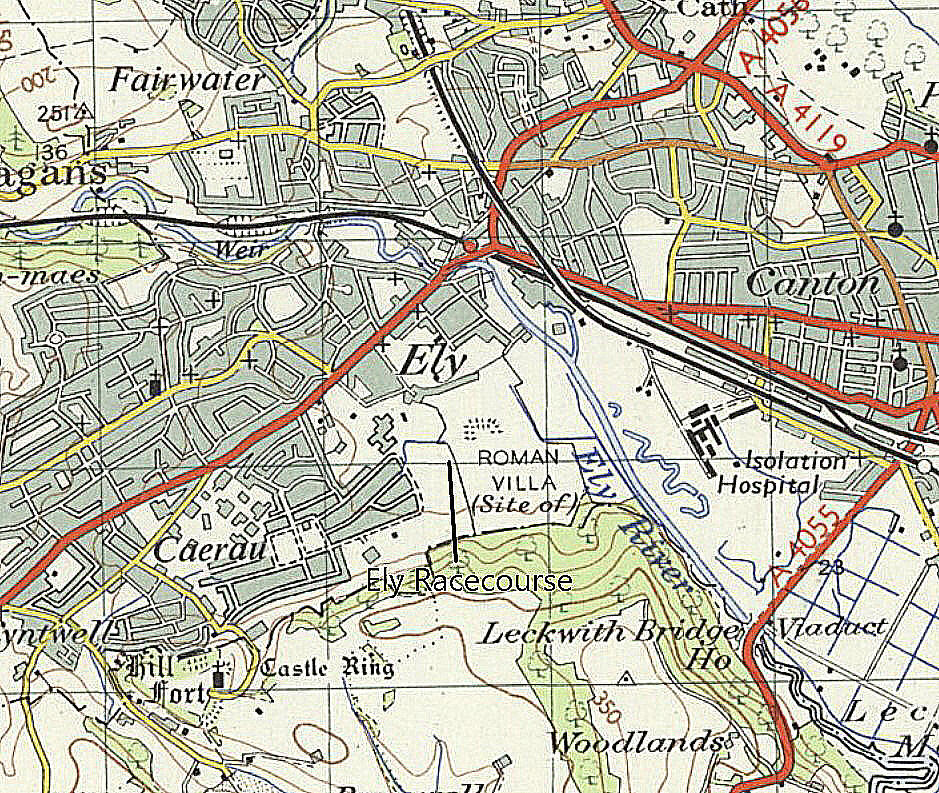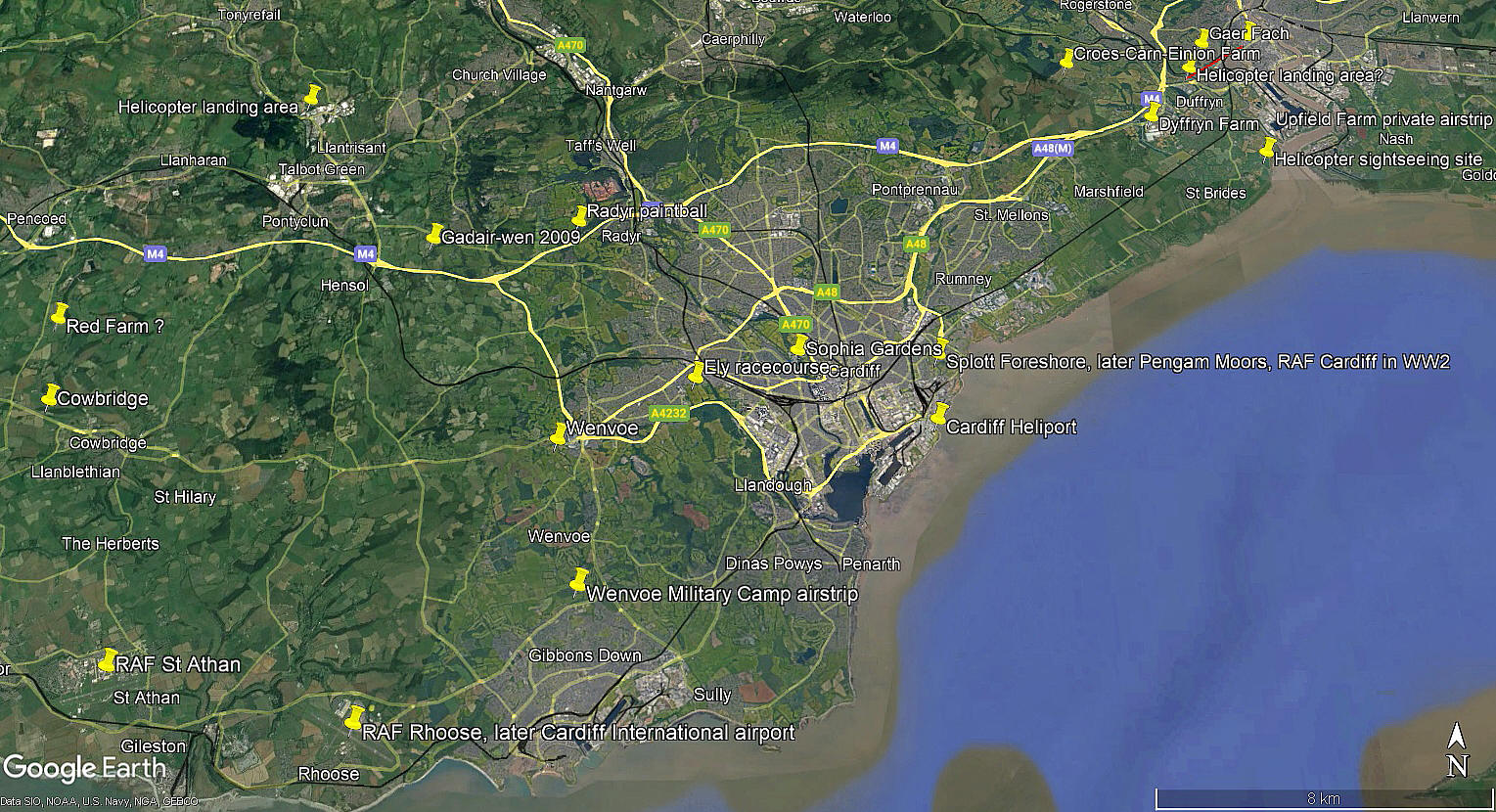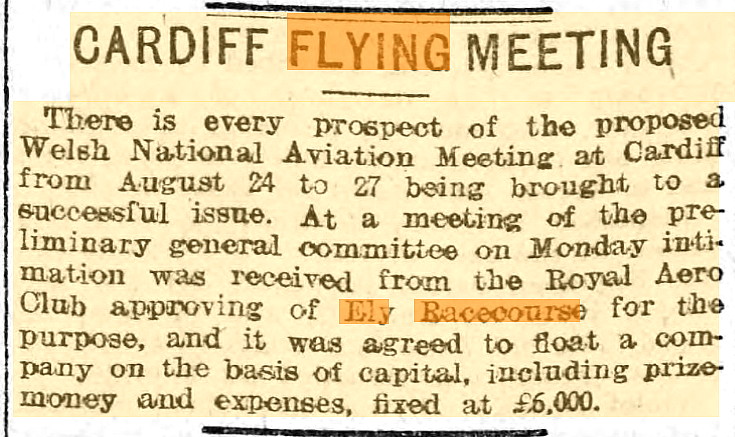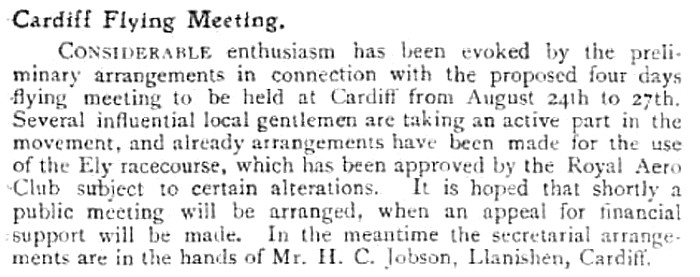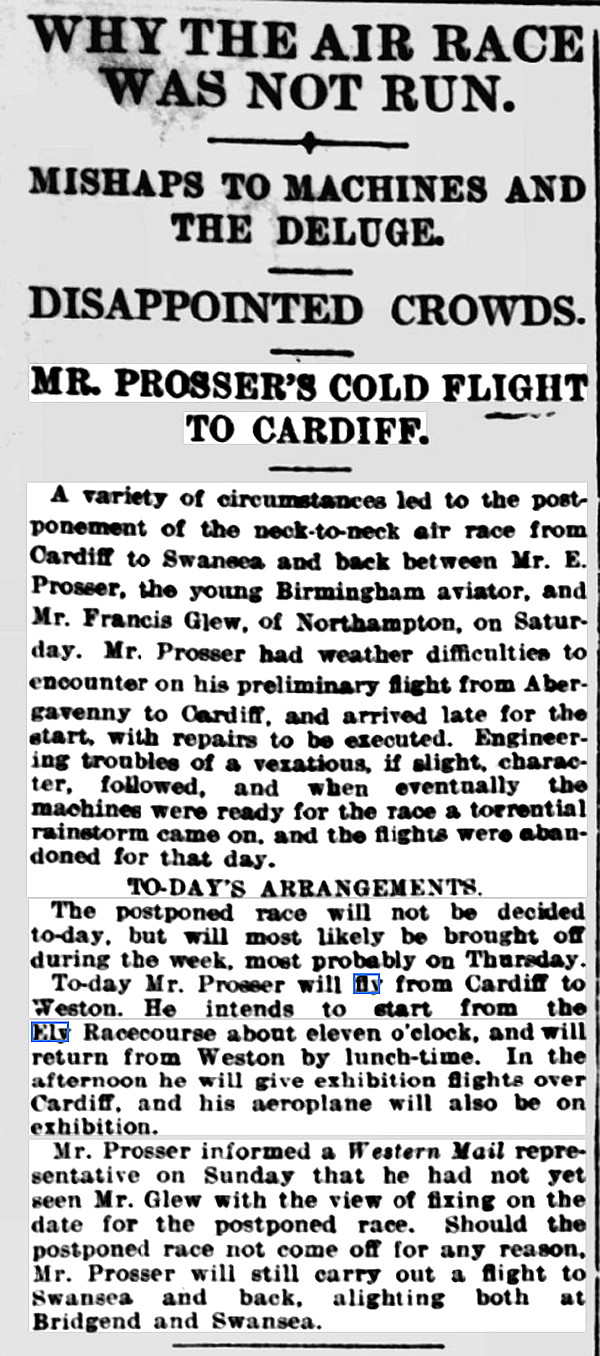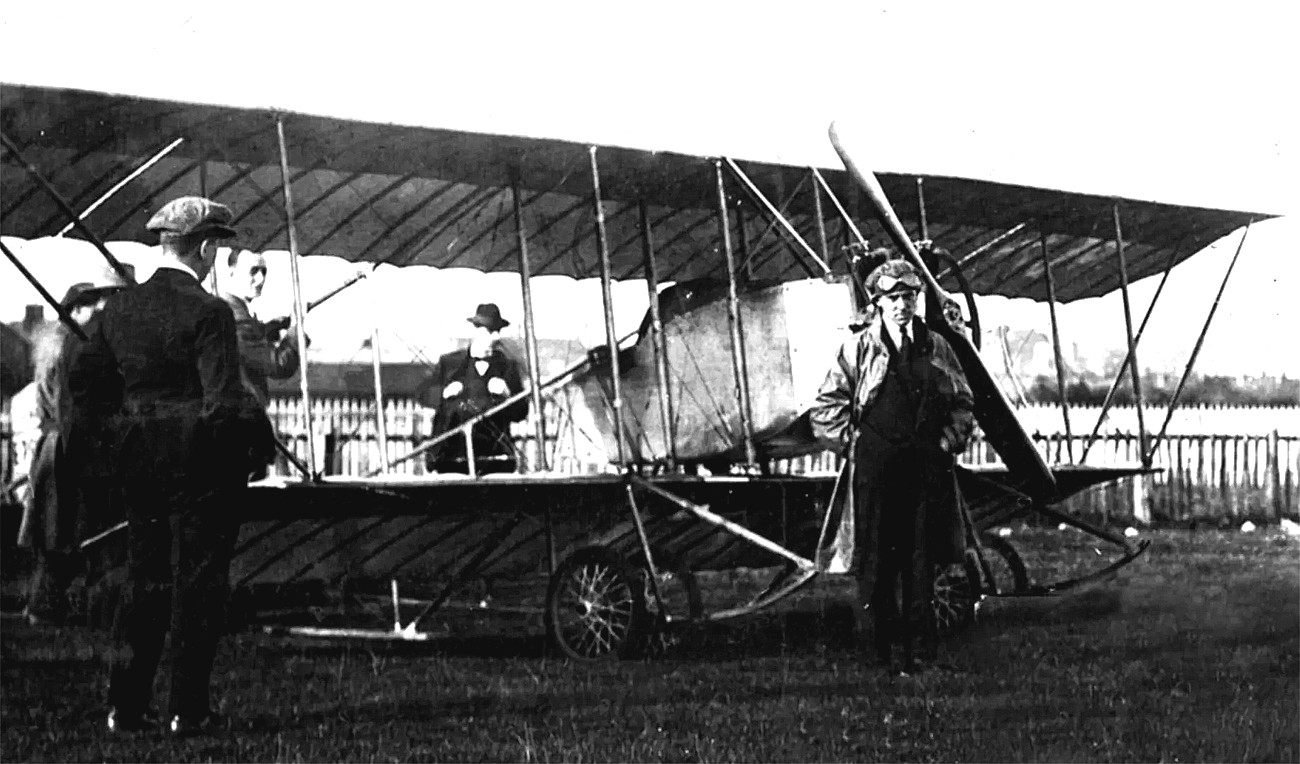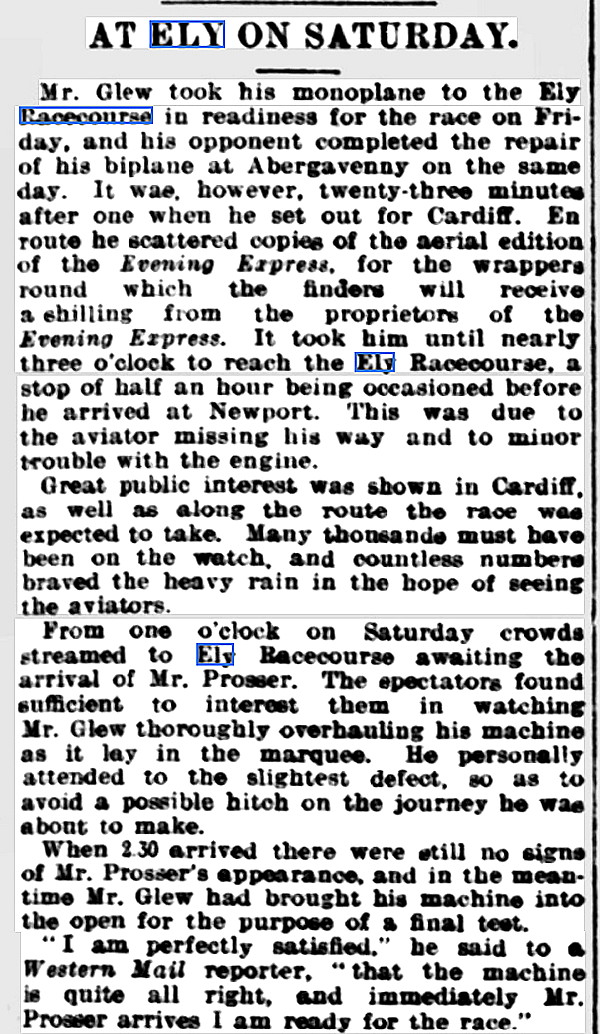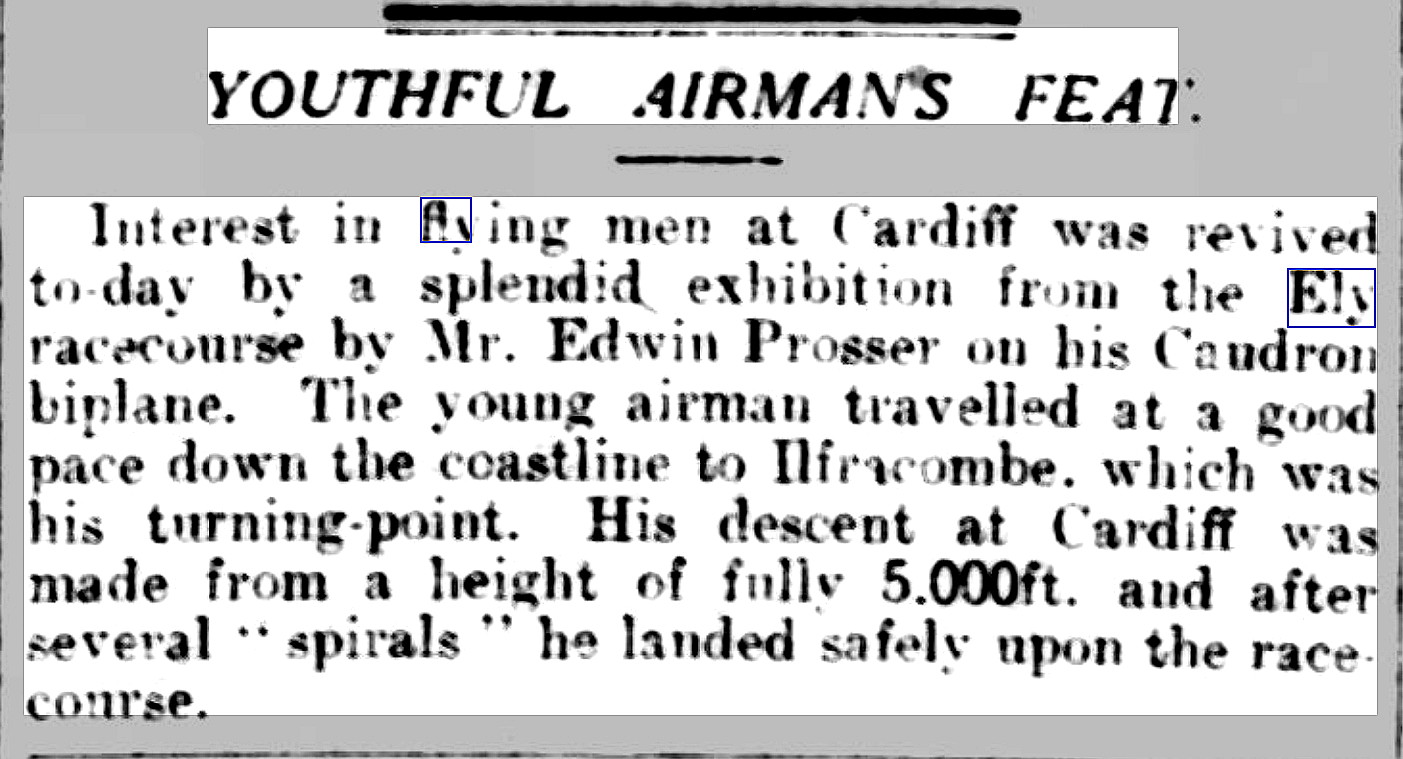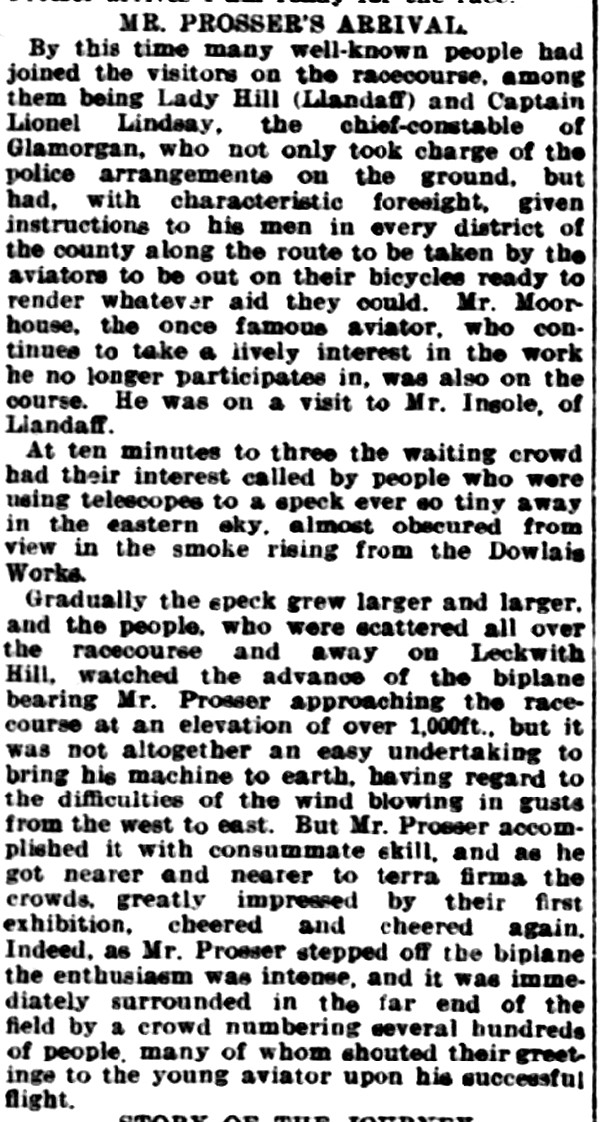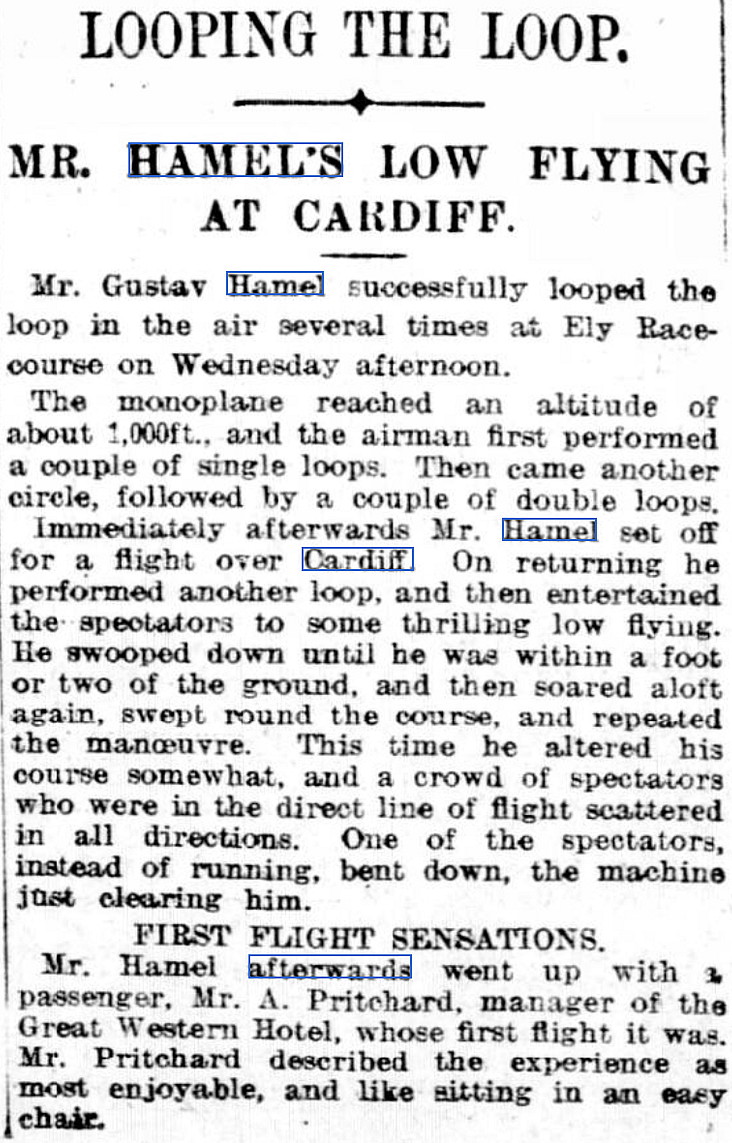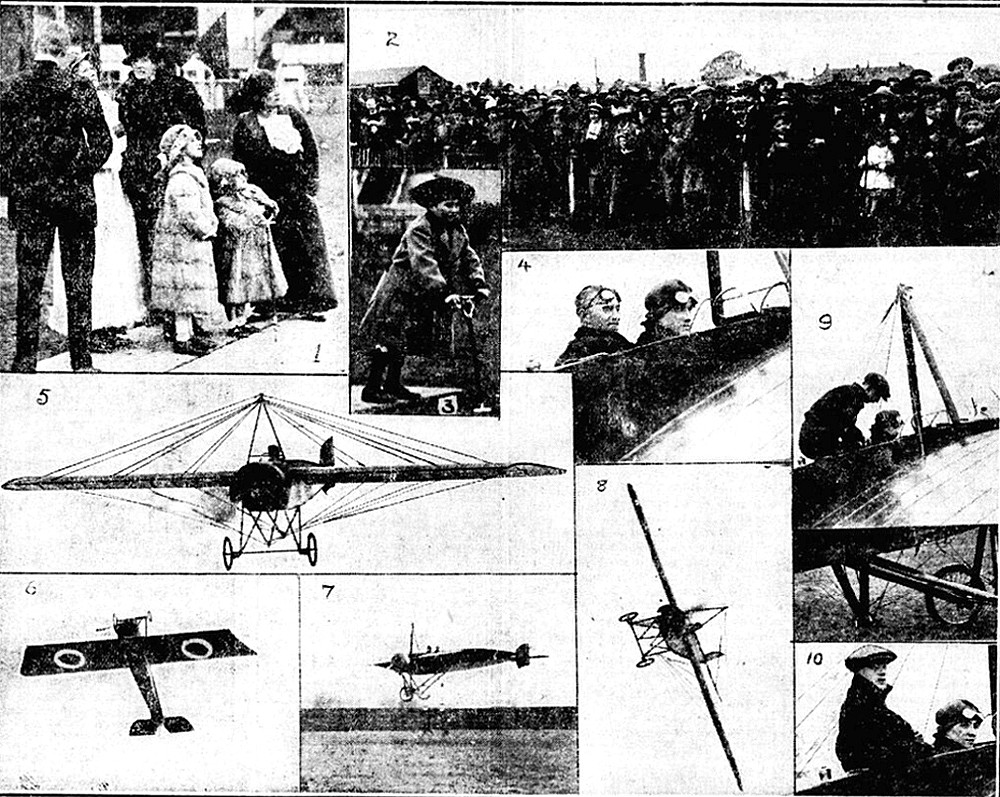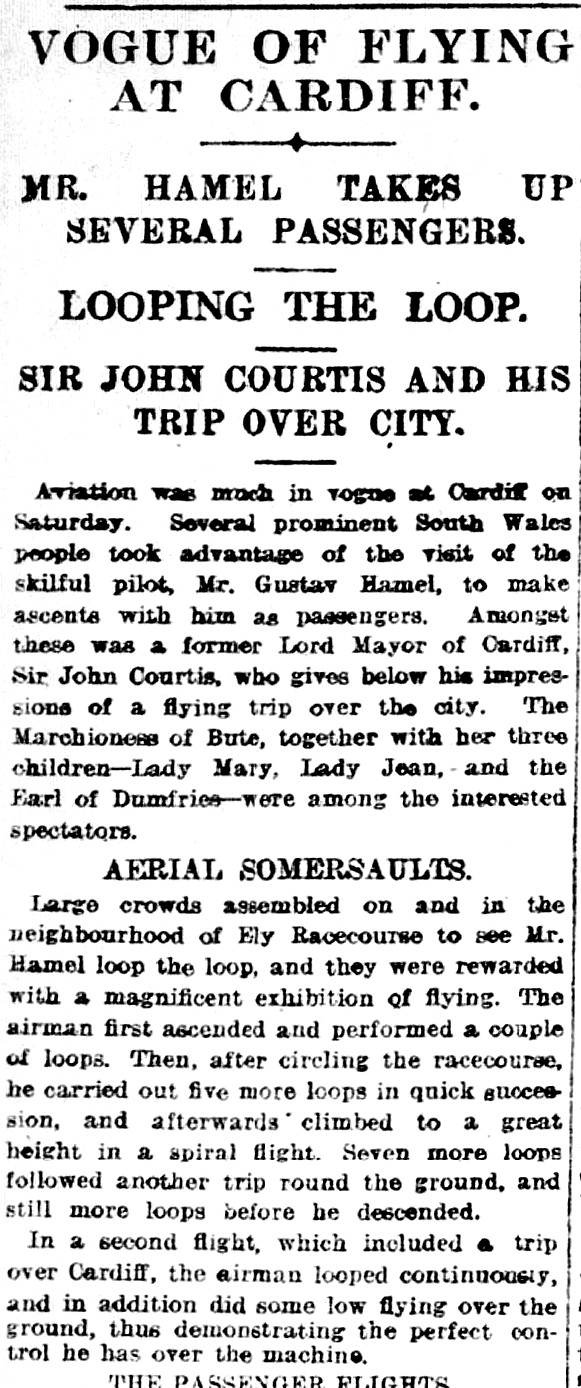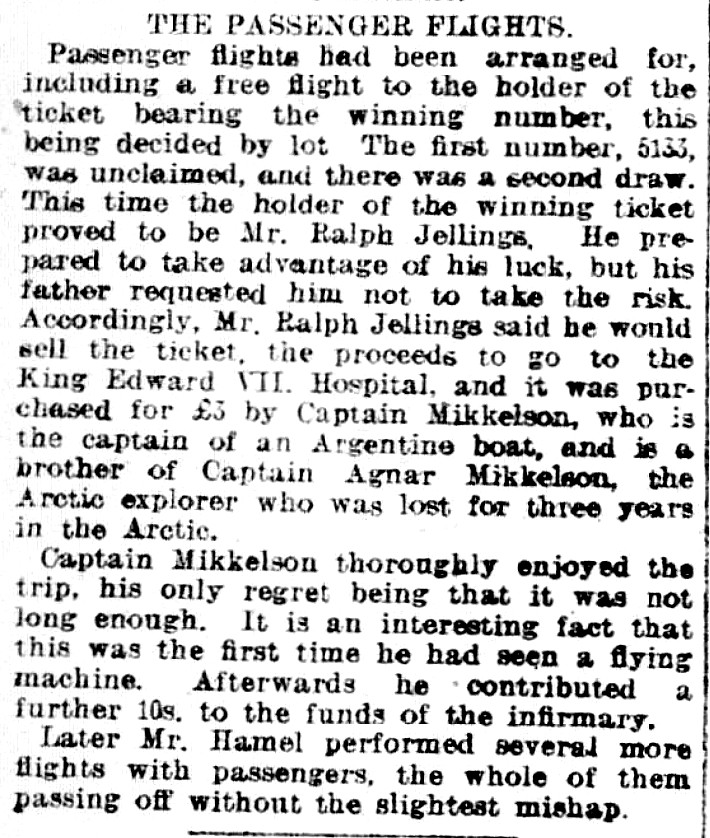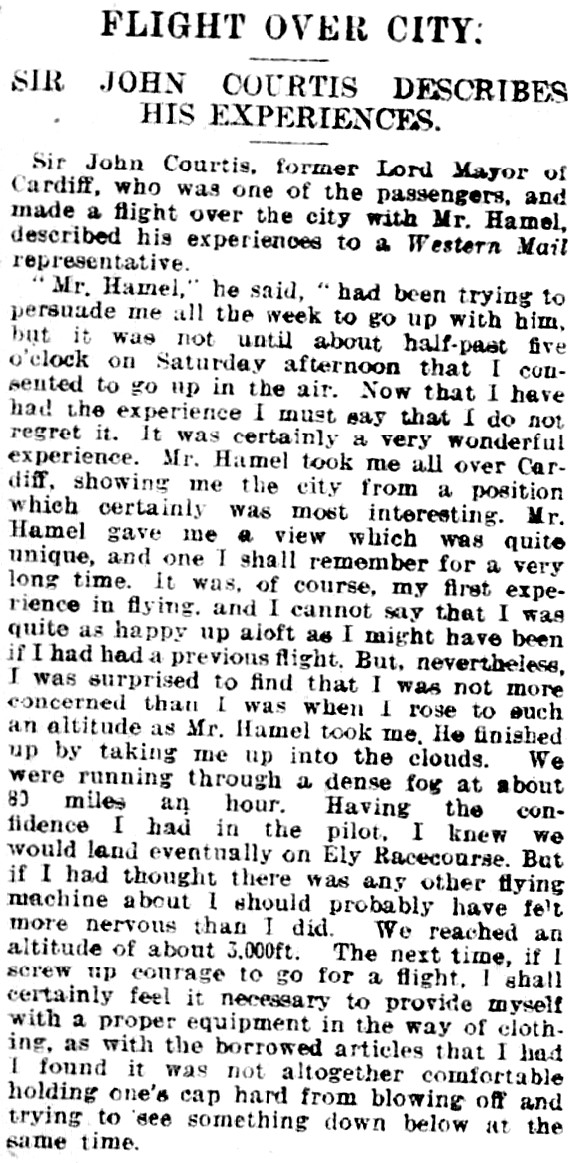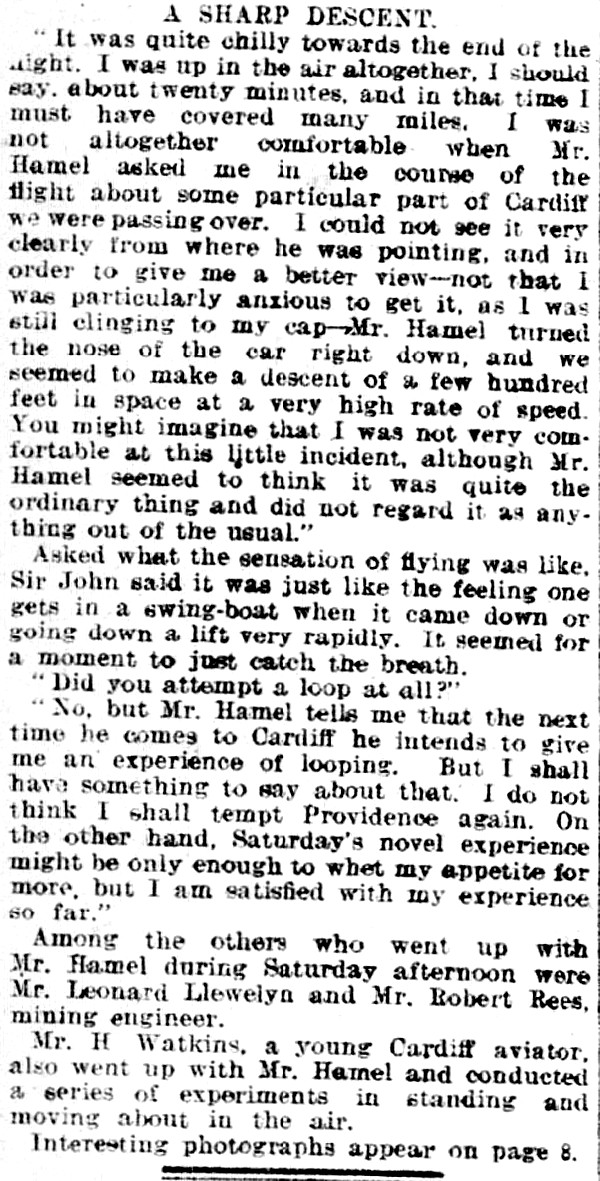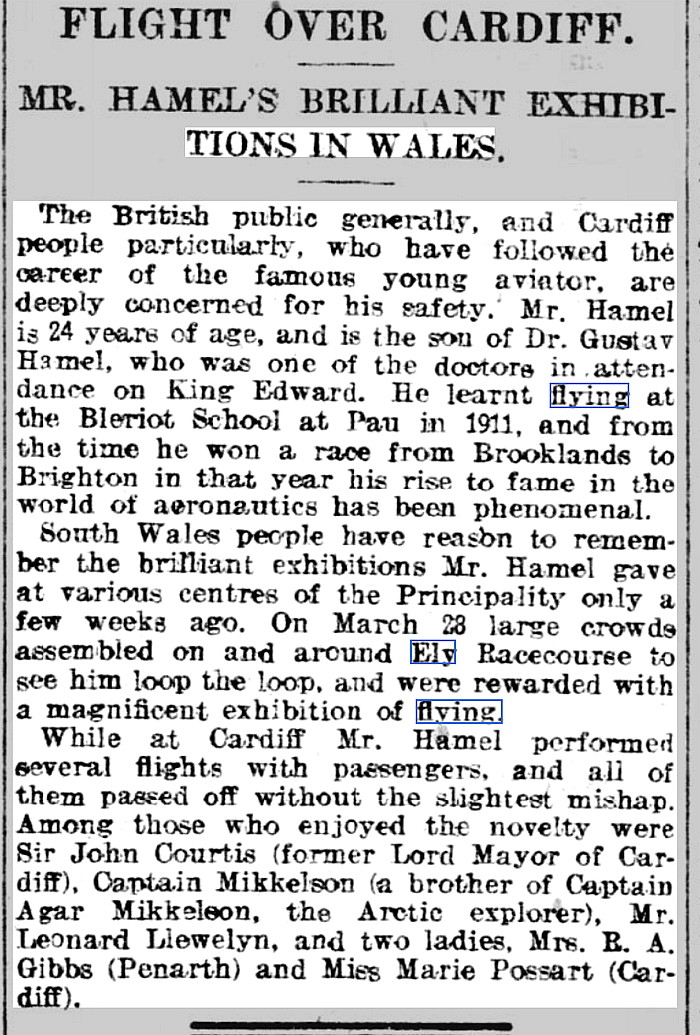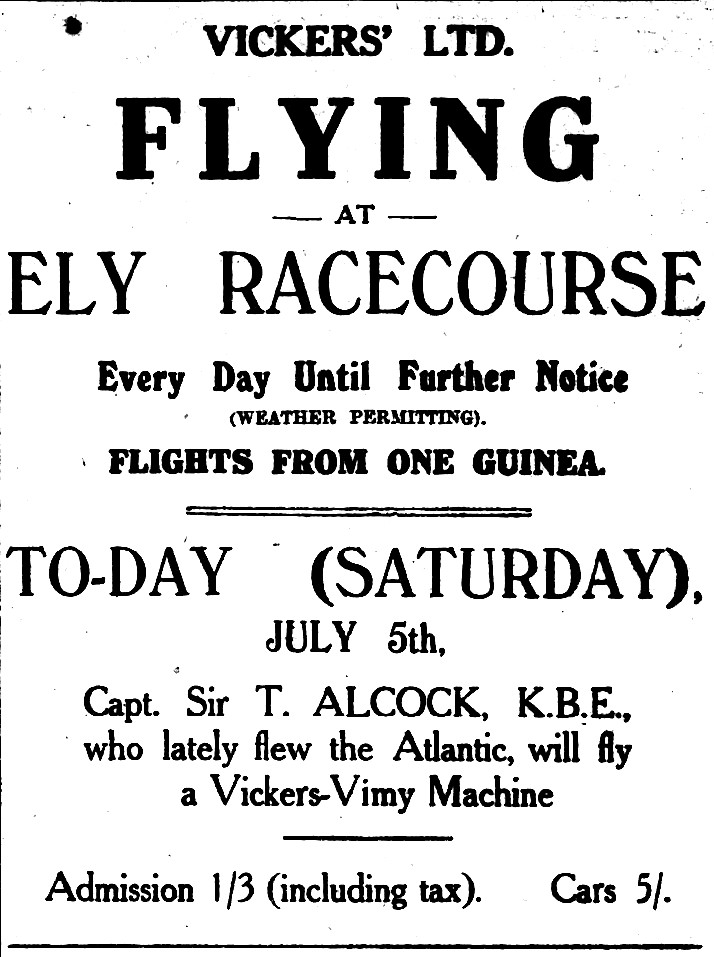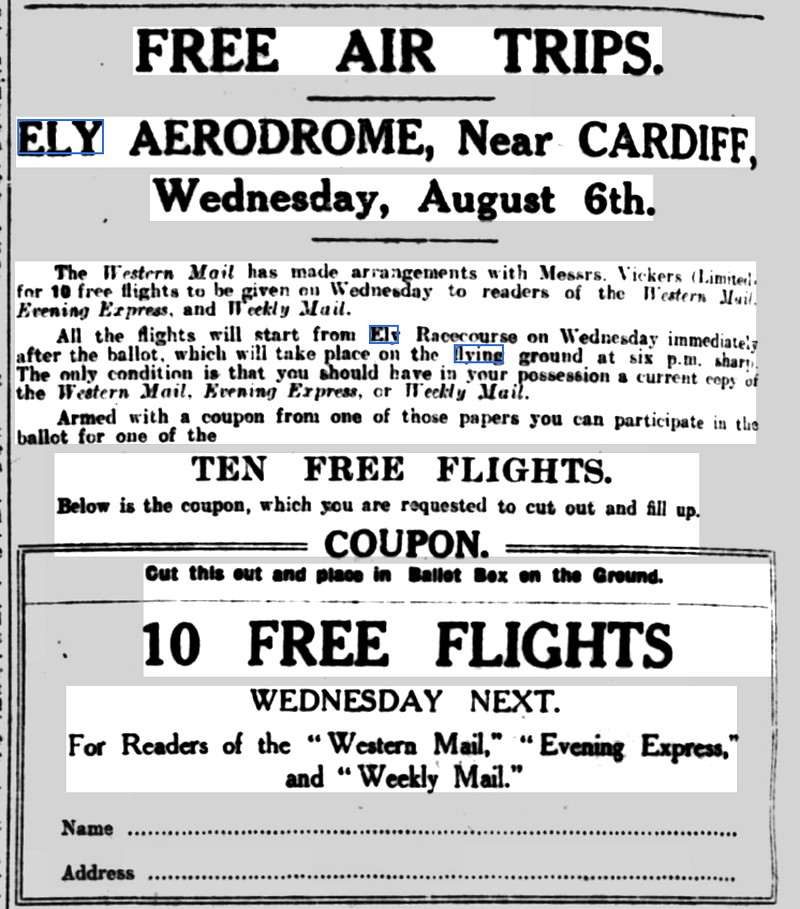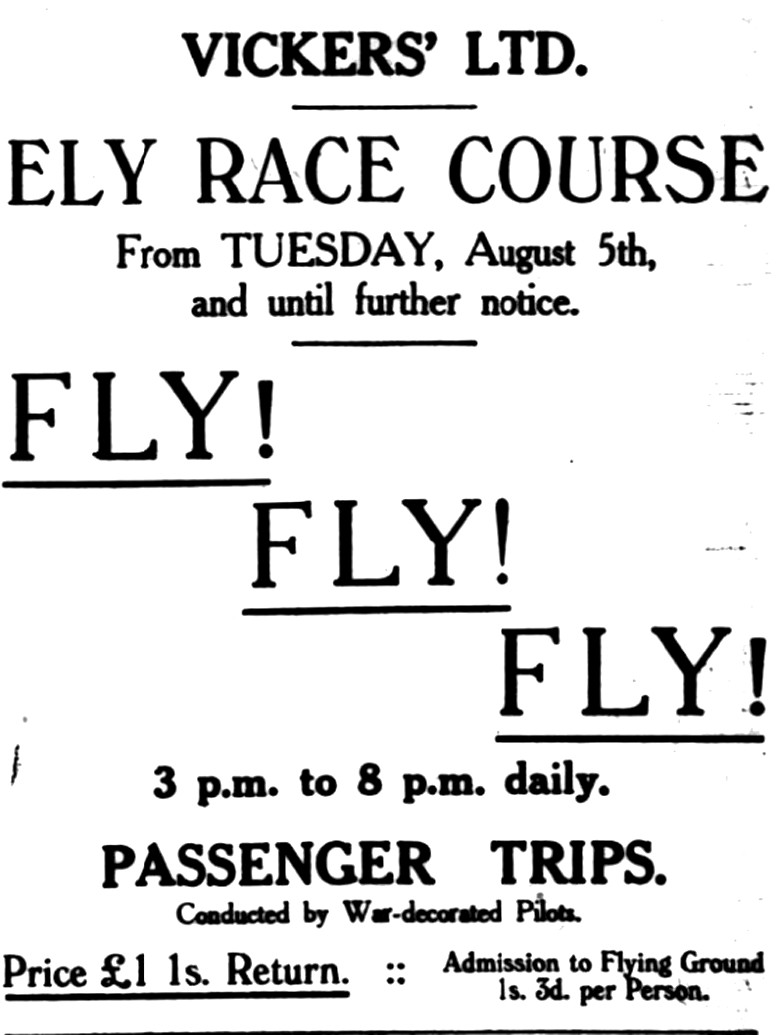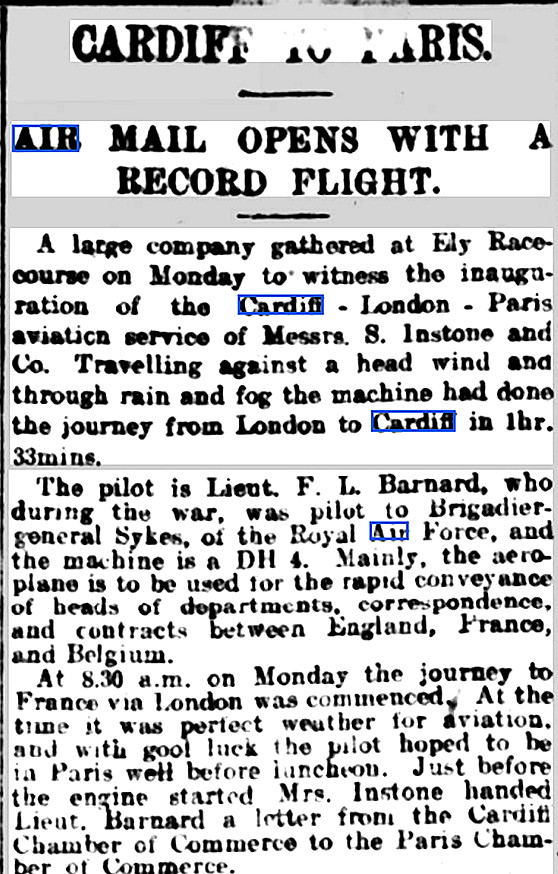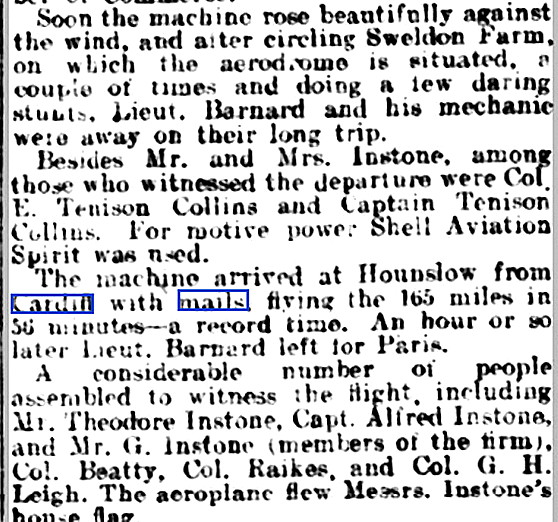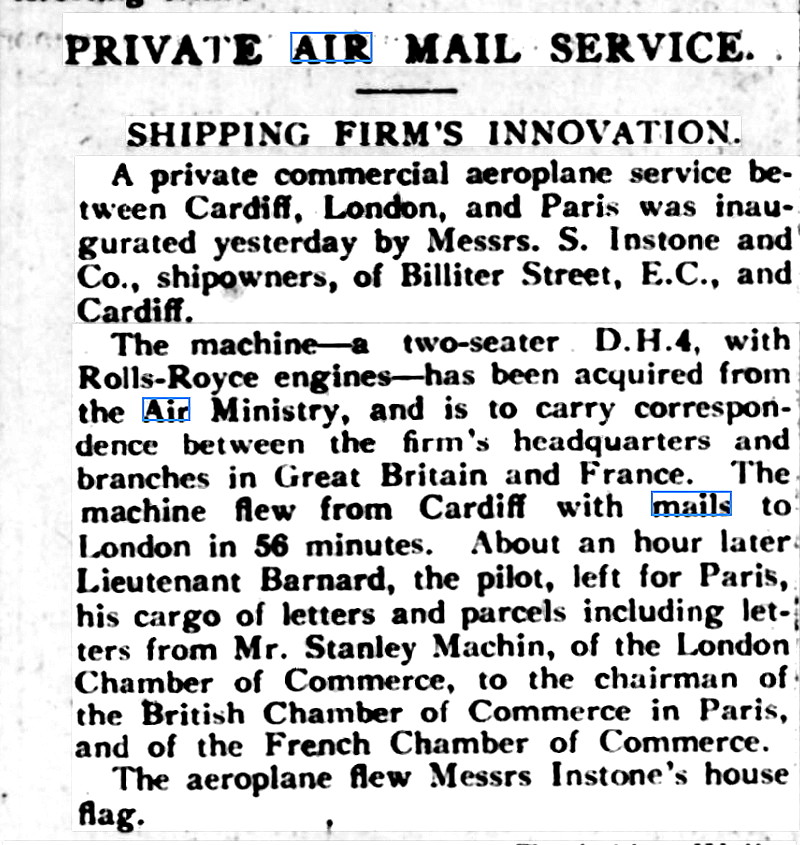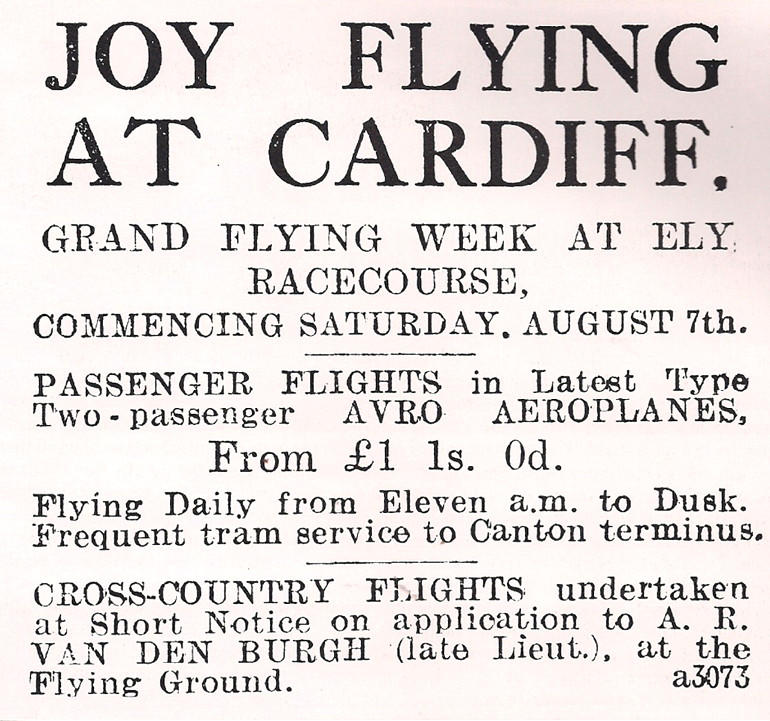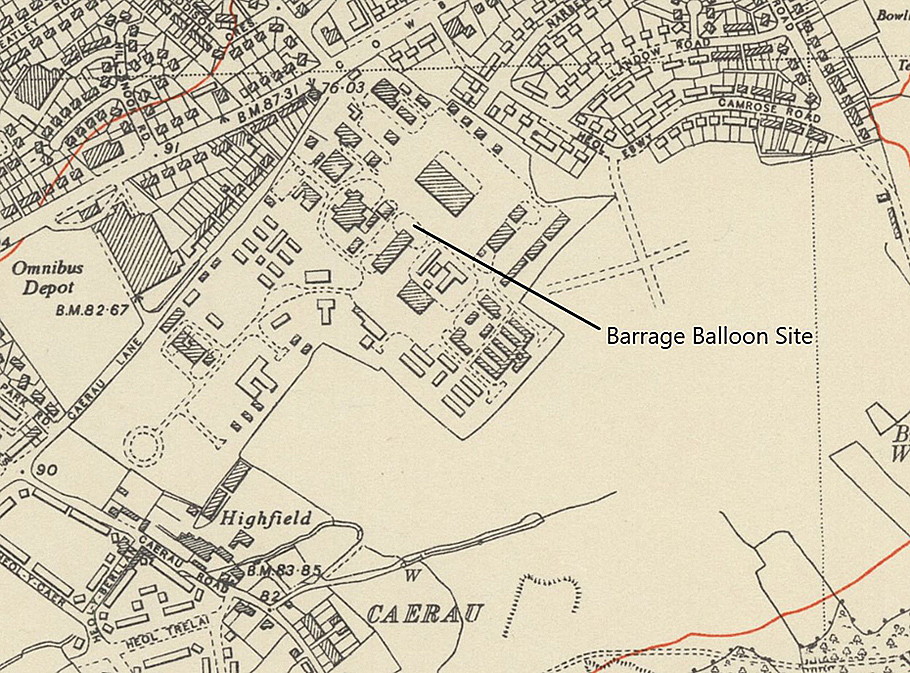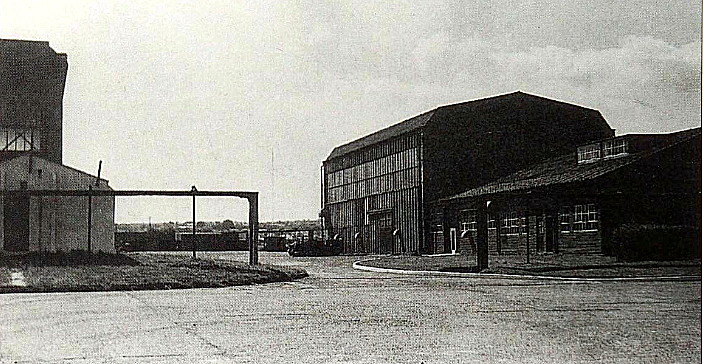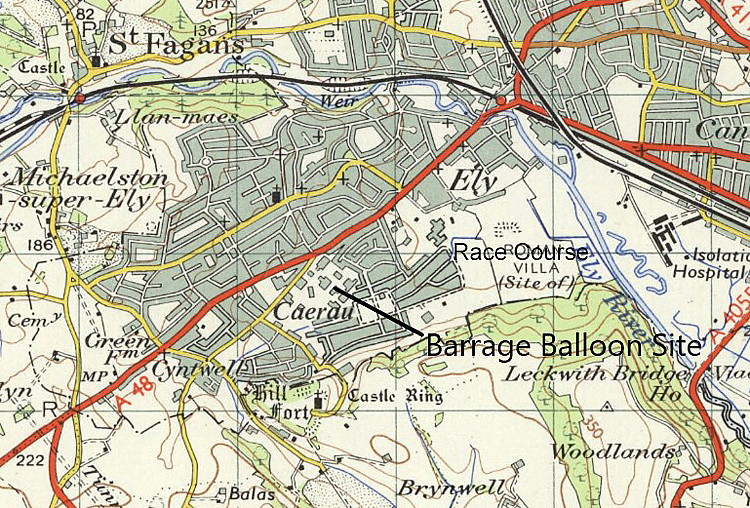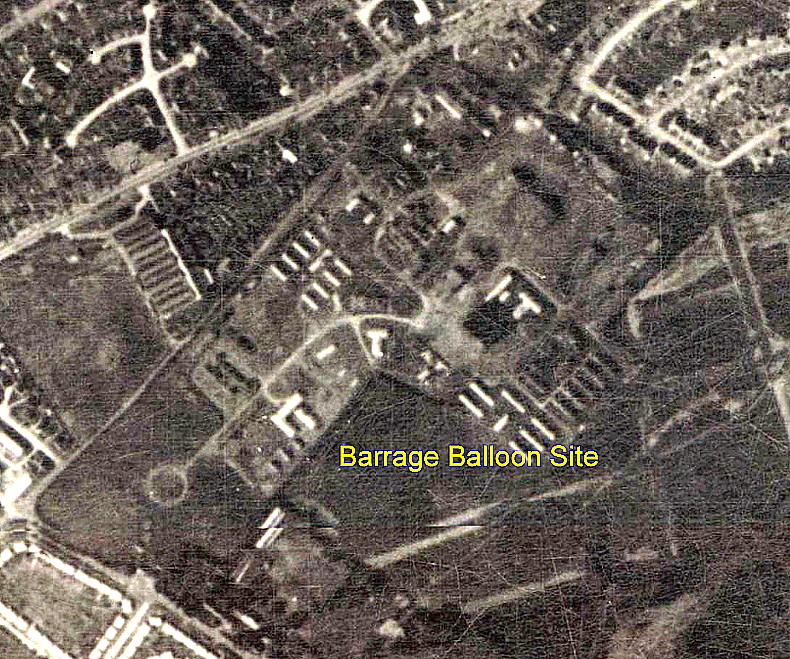Ely racecourse
ELY RACECOURSE: Temporary use for joy-ride and airshow displays
Note: The eastern part now known as TRELAI PARK. As far as I am aware, although used many times over many years, this location cannot be regarded as a permanent aerodrome.
Period of operation: 1911 until the 1930s
Location: About 3 to 3.5nm W of Cardiff city centre
A MICHAEL T HOLDER GALLERY
We have to thank Mike Holder, a great friend of this 'Guide', for doing the research about use in 1911 and providing the maps, articles and pictures.
A NOTABLE EVENT
The arrival of Bentfield 'Benny' Hucks, for three days, attracted a great deal of interest, as he was already a famous British aviator. Not least for conducting an air-to-ground radio experiment during this visit. He was also the first Briton to perform a loop, but that was at HENDON in 1913.
The photo plus caption was published in The Sphere on the 30th September 1911. The article was published in Flight magazine on the 30th September 1911.
The two part article was published in the Morning Leader on the 25th September 1911. The next article was published in Flight magazine on the 7th October 1911.
The excerpt is from Blackburn Aircraft by A Jackson. The area view is from my Google Earth © derived database.
NOTES:
As pointed out above, there appears to be no record of this venue being an established aerodrome in the sense of being in continuous operation. However, it certainly was a popular venue. Having finished investigating the visit by Hucks in September 1911, Mike Holder decided to see what else was available, and as you can see, there is quite a lot. I shall attempt to list the items in chronological order.
1910
The short article was published in the Cardiff Evening Express on the 5th July 1910. The article was published in Flight magazine on the 11th July 1910. As far as can be determined this event did not take place. Trying to organise a major aviation event was in the minds of many people at that time.
The inspiration was the Grand Semaine d-aviation de la Champagne, held near Reims in northwest France, from the 22nd to the 29th August 1909. In the early years of powered aviation the French were way in advance of any other nation, and many French people will insist - "We still are!"
That event was a massive success, attracting the attention of the world. Trying to capitalise on this the British typically screwed things up, with Blackpool and Doncaster going head to head in October 1909. In effect they split the field of available aviators, so neither event had the impact that the French had.
1913
Note: Article One, Two and Three in this section were all published in the Western Mail on the 15th Sepember 1913. It was not uncommon in those days, before radio, for popular newspapers to print two or more editions per day. The photo of Mr Prosser was obtained from Wales On Line and undated. We think it must have been taken on, or about, the 13th September 1913.
The short article was published in the Daily Citizen (Manchester) on the 16th September 1913.
1914
The first article was published in the Western Mail on the 26th March 1914. The photos were published in the Western Mail on the 30th March 1914.
This article in four parts, to hopefully make it easier to read, was published in the Western Mail on the 30th March 1914.
This article was published in the Western Mail on the 26th May 1914. By this time Gustav Hamel had attained super-star status in the UK. Arguably far greater than anything seen before or since. Indeed the most famous aviators of that time were regarded as being super heroes. When they performed an exhibition of flying thousands would attend. Civic banquets would be held, and, if the even took place on a weekday, very often a public holiday would be announced. I cannot recollect that accolade being accorded to any pop-star or film star.
1919
The first advert was published in the Western Mail on the 5th July 1919. The second, also published in the Western Mail, was on the 2nd August 1919, closely followed by the third published on the 5th August.
A NOTEABLE FIRST
In October 1919 Instone Airline decided to make an inaugral, (and record breaking), flight carrying air mail from Cardiff to Paris. They landed en route at HOUNSLOW to clear Customs.
The short article is from Wenvoe Online. The article in two parts was published in the Western Mail on the 14th October 1919. The last item was published in the Bayswater Chronicle on the 25th October 1919. It is of course a time honoured tradition, especially in the popular press, to never publish an article that is factually correct. The fool who wrote the article in the Bayswater Chronicle says that the DH.4 has "Rolls-Royce engines." It does of course have only one engine.
1920
This advert was published in the Western Mail on the 7th August 1920. The event was being organised by Vickers.
I am quite certain that given time evidence of other operators using this location will be found. Another mention I have found is for the North British Aviation Co. making a visit here from the 27th April until the 3rd May 1931.
If anybody can kindly offer advice and information, this will be most welcome.
CAERAU: Barrage Balloon Depot
Note: The photo of the barrage balloon sheds was obtained from The Illustrated History of Cardiff's Suburbs by Dennis Morgan.
NOTES: Whilst investigating the history of ELY RACECOURSE Mike Holder also discovered this location, just to the west. Presumably these barrage balloon sheds (or hangars), were erected in or around WW2? In the UK the buildings used for the storage of aircraft and airships were called sheds. The term hangar comes from the French language, and adopted during WW1. It being very useful indeed to easily differentiate usually very large structures as opposed to what you might build in your back garden.
Right from the start of this project the object was to cast the net across the subject of "flying sites" as far and as wide as possible. Which is why large tethered balloons came into the frame. In WW1 large tethered balloons were invariably used for spotting, (or observation duties), especially for directing artillery, before aircraft became widely available. These being manned of course.
One positive aspect of producing this 'Guide' is that it has enabled me to add vast amounts of ignorance to my already impressive collection. And indeed, added to on a daily basis. Always nice to have achieved something notable in life! For example, as far as I was aware, barrage balloons in WW2 were unmanned? Or perhaps, were there some exceptions? I do know that after WW2 some barrage balloons were fitted with gondolas to enable parachuting practice jumps.
If anybody can kindly offer advice, this will be much appreciated.
We'd love to hear from you, so please scroll down to leave a comment!
Leave a comment ...
Copyright (c) UK Airfield Guide















